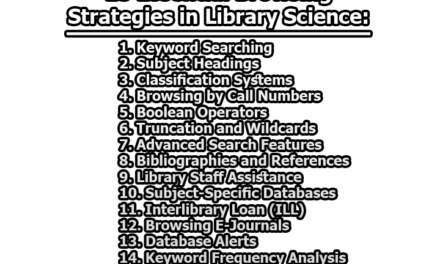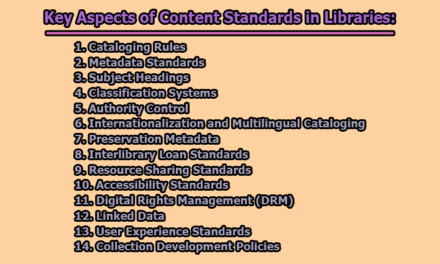Resource Sharing and Information Networking both are dependable on each other to fulfill the demand of the institutional users.
Resource sharing means the existing resources in a comparing system can be accessed or men remotely accessed across multiple administrative domains. Resource sharing is not a new concept in the fields of libraries. The concept was identified by the term of library co-operation.
The term “Resource Sharing” is necessary because any library or information centers can share their resources including the resources of information, staff, expertise, infrastructure, and finance.
Information networking is a set of two or more computers connected together to share information and resources link printed or hard disk etc. It is set on interrelated information systems associated with communication facilities.
The term “Information Networking” is also necessary which, transmit information or data form, one library, or other information centers to another. Networking has become a very powerful link in the co-ordination & dissemination of resources.
So, Resource Sharing and Information Networking are used as the alternative efforts of information exchange among libraries.
Basic Agreement of Resource Sharing and Information Networking:
In order to achieve the goals in Resource Sharing & Information Networking, some basic agreements among the participating libraries have to be made. In this regard P.N. Kaula (1986) points out the following:
- An agreement has to be reached to share currently owned materials.
- There should be agreement on acquisition policies.
- There should be agreement on bibliographic controls.
- There should be an agreement on building a specialized collection.
- There should be agreement regarding the loan’s periods on renewals of materials.
- There should be agreement on the financial implication involving the loan of materials from one library to another.
- An agreement has to be reached on the retrieval of materials to a common storage facility.
- An agreement has to be made regarding the basic records that have to be maintained in the resource sharing system.
- There should be agreement regarding the compilation of the union catalogue.
Factors Influencing Resource Sharing and Information Networking:
1. Environmental Factors: It includes the following factors;
- Demographic changes (demography is the science of study of the population)
- Transport Patterns: modern transport is needed for commuting swiftly.
- Rapid Expansion of Higher Education: Expansion of higher education has created pressure on the library for extended resources and services.
- Financial and Political pressure by the Government: Pressure for cutting budget and expenditures, political pressure for the corporation.
2. Organizational Factors: It includes;
- Structure of the library and information services.
- Size and Resources (kinds of stuff, funding, and physical facilities)
- Functions and Objectives of the Library (needs to be some among the member libraries)
- Organizational Process (service process, membership process)
- Library Structure (Building Structure)
3.Technical Factors: It includes;
- Computer and relative devices
- Network and communication technology
- Reprographic technology
- ICT competency
4. Human Factors: It includes;
- Co-operative personality (library personnel/staff should be co-operating)
- Positive attitude (interacts with own and other library users, physical rewards)
Objectives of Resource Sharing and Information Networking:
Following are a few objectives of Resource Sharing and Information Networking;
- The core goal of RS is the maximize the availability of materials and services to minimize expenses.
- Increased Availability and Accessibility of resources: Clientele of the participating libraries will have access to resources available in all the libraries. Resources can be moved from one library to another manually or through modern means to easy access and free flow information.
- To Diminish Cost: Resource Sharing helps in building the specialized collection and all participating libraries need not duplicate the procurement of similar materials. This facility’s availability of larger collection and even the basic materials required by the user can be obtained without causing much delay.
- Promote Exploitation of Resources: Resource sharing advocates making reading materials of one library available to the clients of other libraries. Thus, resource sharing exposes the reading materials to a wider group of users. Similarly, the services of a library can be exploited by the users of other libraries.
- Assist member libraries in the section of materials.
- Purchase catalogue and process library materials.
On the basis of experience and involvement in resource sharing activities in the area of management it can be visualized that the management institution can have the following objectives for their resource sharing initiatives;
- To provide better service
- Collection and facilities
- To avoid duplication
- To share experiences
- To face financial crunch
- To promote interaction
- To provide wider access to users
- To provide high-quality information support services.
Functions of Resource Sharing and Information Networking:
Mentionable some functions are being:
- Co-operative acquisition (collection of library materials)
- Assignment of specialization in materials acquisition.
- Co-ordinated subscription
- Exchanges of duplicate holdings
- Co-operative cataloging (CIP)
- Co-operative storage
- Reciprocal borrowing privilege
- Reference service
- Referral service
- Interlibrary loan
Activities of Resource Sharing and Information Networking:
Some activities of Resource Sharing (RS) & Information Networking (IN) are given below;
- Union catalogue of books and periodicals
- Reparation and service of indexing and abstracting
- List of new arrivals on acquisition or accession
- Bibliographical development
- Networking news letter
- Directories and inventories
- Manual for training
- Translation services
- Survey of user’s interest
- Joint research project
- In-service personnel training
- Workshop, meeting, and seminar
- Making networking service
Barriers of Resource Sharing and Information Networking:
In 1968 ALA determined the following barriers to Resource Sharing and Information Networking;
i. Physical Barriers: Losses of local-autonomy clash of personality, unwilling to experiment, inertia, and in-differences.
ii. Traditional and Historical Barriers: Inadequate funds fear by larger librarians being overused, under-compensated, inadequacy to serve their own needs, institutional competition.
iii. Lack of Information and Experience: It includes;
- Lack of knowledge about the needs of users.
- Unpredictable demand of legitimate users.
- Failure of small libraries to realize the value of resources of larger co-operative efforts.
iv. Physical and Geographical Barriers: It includes;
- Distance between libraries
- Distance of user from libraries
- Distance in size of the collection
- Lack of space
- Delays in satisfying the needs and requests of users.
v. Legal and Administrative Barriers: It includes;
- Too many governments and other units.
- Lack of communication across jurisdictional lines.
- Incompatibility of equipment and procedures.
- Lack of properly trained staff.
- Lack of appropriate legislation.
- Lack of creative administrative leadership.

Library Lecturer at Nurul Amin Degree College










